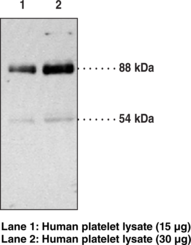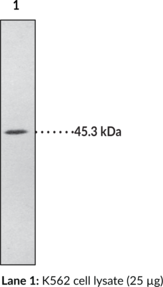Description
GABAA receptors are ligand-gated chloride channels that mediate the effects of the inhibitory neurotransmitter GABA in the CNS.{46949,46950} They are postsynaptic heteropentameric receptors that contain protein subunits from the following isoforms: α1-6, β1-4, γ1-3, δ, ε, π, θ, and ρ1-3, arranged around a central pore. Phasic inhibitory synaptic transmission is regulated by α1β2γ2 subunit-containing GABAA receptors, the major isoform found in the brain.{46950,46951} The α subunit of GABAA receptors interfaces with a β subunit to form the GABA binding site that initiates GABA-induced action potentials and forms the benzodiazepine binding site with the γ subunit. GABAA α3 subunit expression is decreased in neocortical tissue samples surgically isolated from patients with medically refractory temporal lobe epilepsy.{55213} Knockdown of Gabra3, which encodes the α3 subunit isoform, prevents stress-induced colonic inflammation in mice.{55216} Cayman’s GABAA Receptor α3 Subunit (N-Term) Polyclonal Antibody can be used for immunohistochemistry (IHC) and Western blot (WB) applications. The antibody recognizes the GABAA receptor α3 subunit at approximately 51 kDa from mouse and rat samples.
Synonyms: GABAA Receptor Subunit α3|GABRA3|γ-Aminobutyric Acid Receptor Subunit α3
Immunogen: Synthetic peptide from the N-terminal region of the α3 subunit of the rat GABAA receptor
Formulation: 100 µl of affinity-purified polyclonal antibody
Isotype:
Applications: IHC, WB
Origin:
Stability: 365 days
Application|Immunohistochemistry||Application|Western Blot||Product Type|Antibodies|Polyclonal Antibodies||Research Area|Immunology & Inflammation||Research Area|Neuroscience|Seizure Disorders




